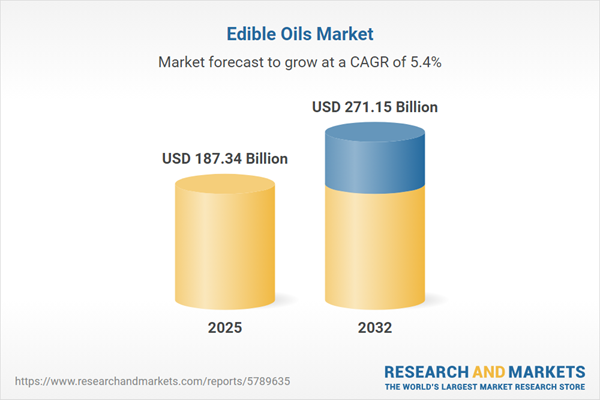Speak directly to the analyst to clarify any post sales queries you may have.
The global edible oils market is undergoing significant transformation, shaped by evolving consumer demands, advances in extraction and packaging, and greater attention to traceable and sustainable sourcing. Senior decision-makers face a landscape where agility, compliance, and technology-driven strategies are essential for growth and risk management.
Market Snapshot: Edible Oils Market Growth and Opportunities
The edible oils market grew from USD 178.29 billion in 2024 to USD 187.34 billion in 2025, projecting a CAGR of 5.38% through 2032, when it is set to reach USD 271.15 billion. Innovation in extraction, a rise in demand for nutritional oils, and global regulatory shifts support this steady expansion, with supply chain integration and technology adoption driving competitiveness for suppliers, manufacturers, and industry leaders worldwide.
Scope & Segmentation of the Edible Oils Market
- Product Types: Includes animal-derived oils and a broad range of plant-based oils such as avocado, canola, coconut, corn, cottonseed, linseed, olive, palm, peanut, rice, sesame, soybean, and sunflower—catering to both nutritional and functional requirements.
- Processing Techniques: Encompass enzymatic extraction for high purity, mechanical pressing (hot and cold-pressed), and solvent extraction optimized for large-scale output.
- Packaging Formats: Offer bottles, cans and jars, drums, pouches, and tins, balancing brand appeal, preservation, and operational efficiency.
- Applications: Span culinary purposes (baking, grilling, frying, salads, sauces), food processing, preservation, personal care, cosmetics, and pharmaceutical uses.
- Distribution Channels: Include offline retail through convenience outlets, specialty stores, supermarkets and hypermarkets, as well as robust online retail platforms.
- Regional Coverage: Analyzed across the Americas (North and Latin America), Europe, Middle East, Africa, and the Asia-Pacific region, reflecting distinct regulatory, production, and consumption profiles.
Edible Oils Market: Key Takeaways for Senior Leaders
- Consumer demand for health-oriented, ethically sourced oils is encouraging reformulation, enhanced transparency, and certification across the value chain.
- Technological advances—digital supply chain monitoring, extraction innovations, and traceability tools—are increasing accountability and process efficiency for producers and distributors.
- Policy initiatives targeting sustainability, such as stricter palm oil regulations and circular economy models, are intensifying the push toward renewable feedstocks and waste minimization.
- Regional trends show mature sectors focusing on high-value, specialty oils with clean-label credentials, while emerging markets prioritize affordability and scalable production.
- Adaptation to evolving consumer tastes—including premium blends, convenient packaging, and value-added ingredients—is central to differentiation and premium pricing strategies.
Assessing the Tariff Impact on Global Supply Chains
In 2025, the implementation of revised United States tariffs significantly impacted import sourcing, cost structures, and procurement strategies for edible oil stakeholders. Companies are reacting by diversifying suppliers, optimizing domestic collaborations, and leveraging operational efficiencies to buffer against increased duties. This adjustment is also prompting the development of alternative trade corridors and a heightened focus on supply chain flexibility, resilience, and pricing strategies.
Methodology & Data Sources
This report is grounded in an integrated approach, combining primary research through executive interviews with comprehensive secondary analysis of industry publications, scientific journals, and trade data. Quantitative insights are validated through expert panels and scenario modeling to deliver accurate trend mapping and actionable forecasts.
Why This Report Matters
- Delivers granular segmentation and data-driven insights to inform product, sourcing, and go-to-market decisions.
- Equips leaders to anticipate regulatory changes, sustainability mandates, and shifting consumer preferences for competitive advantage.
Conclusion
The edible oils market is defined by ongoing evolution in technology, sustainability, and consumer demand. Informed strategies, resilient operations, and adaptability will remain vital as companies navigate sector complexity and seize emerging opportunities.
Additional Product Information:
- Purchase of this report includes 1 year online access with quarterly updates.
- This report can be updated on request. Please contact our Customer Experience team using the Ask a Question widget on our website.
Table of Contents
3. Executive Summary
4. Market Overview
7. Cumulative Impact of Artificial Intelligence 2025
Companies Mentioned
The companies profiled in this Edible Oils market report include:- 3F Industries Ltd.
- AJWA Group
- American Vegetable Oils, Inc.
- Archer-Daniels-Midland Company
- Associated British Foods PLC
- Borges International Group, S.L.
- Bunge Global SA
- Canada Pride Foods Inc.
- Cargill, Incorporated
- CHS Inc.
- Data Group
- DEOLEO S.A.
- FUJI OIL CO., LTD.
- GrainCorp Limited
- IOI Corporation Berhad
- J-OIL MILLS , INC.
- Kaneka Corporation
- Louis Dreyfus Company B.V.
- Marico Limited
- Musim Mas Group
- Ngo Chew Hong Edible Oil Pte Ltd by Mewah International Inc.
- Olam Group
- Patanjali Foods Ltd.
- Peerless Holdings Pty Ltd.
- Presco PLC
- PT Sinar Mas Agro Resources and Technology Tbk
- Purti Vanaspati Pvt. Ltd.
- Salad Oils International Corporation
- Sunora Foods Inc.
- The Nisshin OilliO Group, Ltd.
- Titan Oils Inc.
- UEDA OILS & FATS MFG. CO.,LTD.
- Vicentin S.A.I.C
- Wilmar International Ltd.
Table Information
| Report Attribute | Details |
|---|---|
| No. of Pages | 195 |
| Published | November 2025 |
| Forecast Period | 2025 - 2032 |
| Estimated Market Value ( USD | $ 187.34 Billion |
| Forecasted Market Value ( USD | $ 271.15 Billion |
| Compound Annual Growth Rate | 5.3% |
| Regions Covered | Global |
| No. of Companies Mentioned | 35 |









